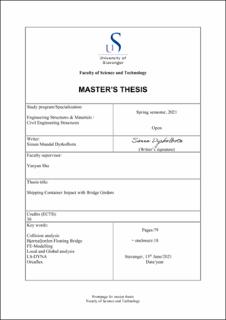| dc.description.abstract | Aluminium bridge decks have been proposed as alternatives to traditional steel bridge
decks. These girders can meet all design criteria for bridges and have the advantages
of low density and high corrosion resistance. Regardless of girder material, one critical
issue in bridge design is to ensure the safety of bridge girders under accidental ship
collisions. Such collision accidents can occur in earthquake or tsunami inundation, due to
ship maneuvering errors or mechanical failures. The bridge girder strength against ship
collision load should be carefully checked to avoid large local damage in the impacted
region and further degradation of global bridge safety. Some studies have been conducted
for ship deckhouse and forecastle impacts with bridge girders. However, bridge decks
are also under the impact of stacked shipping containers from cargo ships. Considering
the lower elastic modulus and ductility of aluminium material compared with steel,
aluminium bridge girders may be more vulnerable to collision loads.
The thesis work is divided in two parts. The first aims to numerically investigate the
local structural response of bridge girders under shipping container impacts for steel and
aluminium girders. FE- Models of a bridge section and a 20 ft standard shipping container
are developed in LS-DYNA. The strain rate effect of the aluminium girder is investigated. The
impact force, structural damage, and energy dissipation during the collision are compared
for both materials. The effects of impact angle and vertical location are also discussed.
The second part of the work aims to numerically investigate the global response of the
bridge by using the obtained force-displacement relationship from the shipping container
impact. A global model has been built in Orcaflex. Eigenmodes, moments about the strong
and weak axis as well as bridge motions have been discussed. The conclusions from the
local analysis (published as an article) were that strain rate had a minor effect on the
investigated aluminium alloy. In addition, a significant reduction of contact force was
observed for the aluminium girder due to local fracture leading to larger dissipation of
strain energy. For some head-on collision scenarios, the girder material seemingly plays
a lesser role as long as the stiffness is sufficient to redistribute the impact force over a
larger area. The majority of energy dissipation was observed in the shipping containers.
For the global analysis, there was significant development of strong axis bending moment
and the dynamic displacement was less than expected. The period of the motions post-impact was close to one of the eigen-periods. It should be stated that the modal analysis
did not correlate satisfactorily with the NPRA’s existing reports, which would question
the validity of results in this part. | |
